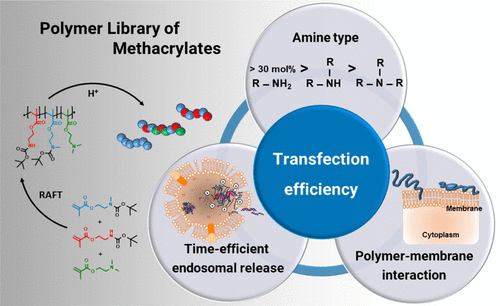当前位置:
X-MOL 学术
›
Bioconjugate Chem.
›
论文详情
Our official English website, www.x-mol.net, welcomes your
feedback! (Note: you will need to create a separate account there.)
Beyond Gene Transfection with Methacrylate-Based Polyplexes—The Influence of the Amino Substitution Pattern
Bioconjugate Chemistry ( IF 4.0 ) Pub Date : 2018-05-01 00:00:00 , DOI: 10.1021/acs.bioconjchem.8b00074 Anne-Kristin Trützschler 1, 2 , Tanja Bus 1, 2 , Martin Reifarth 1, 2, 3, 4 , Johannes C. Brendel 1, 2 , Stephanie Hoeppener 1, 2 , Anja Traeger 1, 2 , Ulrich S. Schubert 1, 2
Bioconjugate Chemistry ( IF 4.0 ) Pub Date : 2018-05-01 00:00:00 , DOI: 10.1021/acs.bioconjchem.8b00074 Anne-Kristin Trützschler 1, 2 , Tanja Bus 1, 2 , Martin Reifarth 1, 2, 3, 4 , Johannes C. Brendel 1, 2 , Stephanie Hoeppener 1, 2 , Anja Traeger 1, 2 , Ulrich S. Schubert 1, 2
Affiliation

|
Methacrylate-based polymers represent promising nonviral gene delivery vectors, since they offer a large variety of polymer architectures and functionalities, which are beneficial for specific demands in gene delivery. In combination with controlled radical polymerization techniques, such as the reversible addition–fragmentation chain transfer polymerization, the synthesis of well-defined polymers is possible. In this study we prepared a library of defined linear polymers based on (2-aminoethyl)-methacrylate (AEMA), N-methyl-(2-aminoethyl)-methacrylate (MAEMA), and N,N-dimethyl-(2-aminoethyl)-methacrylate (DMAEMA) monomers, bearing pendant primary, secondary, and tertiary amino groups, and investigated the influence of the substitution pattern on their gene delivery capability. The polymers and the corresponding plasmid DNA complexes were investigated regarding their physicochemical characteristics, cytocompatibility, and transfection performance. The nonviral transfection by methacrylate-based polyplexes differs significantly from poly(ethylene imine)-based polyplexes, as a successful transfection is not affected by the buffer capacity. We observed that polyplexes containing a high content of primary amino groups (AEMA) offered the highest transfection efficiency, whereas polyplexes bearing tertiary amino groups (DMAEMA) exhibited the lowest transfection efficiency. Further insights into the uptake and release mechanisms could be identified by fluorescence and transmission electron microscopy, emphasizing the theory of membrane-pore formation for the time-efficient endosomal release of methacrylate-based vectors.
中文翻译:

基于甲基丙烯酸酯的复合体的基因转染之外—氨基取代模式的影响
基于甲基丙烯酸酯的聚合物代表了有前途的非病毒基因传递载体,因为它们提供了各种各样的聚合物结构和功能,这对基因传递中的特定需求是有益的。结合可控的自由基聚合技术,例如可逆加成-断裂链转移聚合,可以合成定义明确的聚合物。在这项研究中,我们基于(2-氨基乙基)-甲基丙烯酸(AEMA),N-甲基-(2-氨基乙基)-甲基丙烯酸(MAEMA)和N,N制备了定义的线性聚合物库-二甲基-(2-氨基乙基)-甲基丙烯酸酯(DMAEMA)单体,带有侧链伯,仲和叔氨基,并研究了取代模式对其基因传递能力的影响。研究了聚合物和相应的质粒DNA复合物的理化特性,细胞相容性和转染性能。由于成功的转染不受缓冲液容量的影响,基于甲基丙烯酸酯的复合物的非病毒转染与基于聚(亚乙基亚胺)的复合物的显着差异。我们观察到,含有高含量伯氨基基团(AEMA)的多聚体提供最高的转染效率,而带有叔氨基基团(DMAEMA)的多聚体则表现出最低的转染效率。
更新日期:2018-05-01
中文翻译:

基于甲基丙烯酸酯的复合体的基因转染之外—氨基取代模式的影响
基于甲基丙烯酸酯的聚合物代表了有前途的非病毒基因传递载体,因为它们提供了各种各样的聚合物结构和功能,这对基因传递中的特定需求是有益的。结合可控的自由基聚合技术,例如可逆加成-断裂链转移聚合,可以合成定义明确的聚合物。在这项研究中,我们基于(2-氨基乙基)-甲基丙烯酸(AEMA),N-甲基-(2-氨基乙基)-甲基丙烯酸(MAEMA)和N,N制备了定义的线性聚合物库-二甲基-(2-氨基乙基)-甲基丙烯酸酯(DMAEMA)单体,带有侧链伯,仲和叔氨基,并研究了取代模式对其基因传递能力的影响。研究了聚合物和相应的质粒DNA复合物的理化特性,细胞相容性和转染性能。由于成功的转染不受缓冲液容量的影响,基于甲基丙烯酸酯的复合物的非病毒转染与基于聚(亚乙基亚胺)的复合物的显着差异。我们观察到,含有高含量伯氨基基团(AEMA)的多聚体提供最高的转染效率,而带有叔氨基基团(DMAEMA)的多聚体则表现出最低的转染效率。









































 京公网安备 11010802027423号
京公网安备 11010802027423号